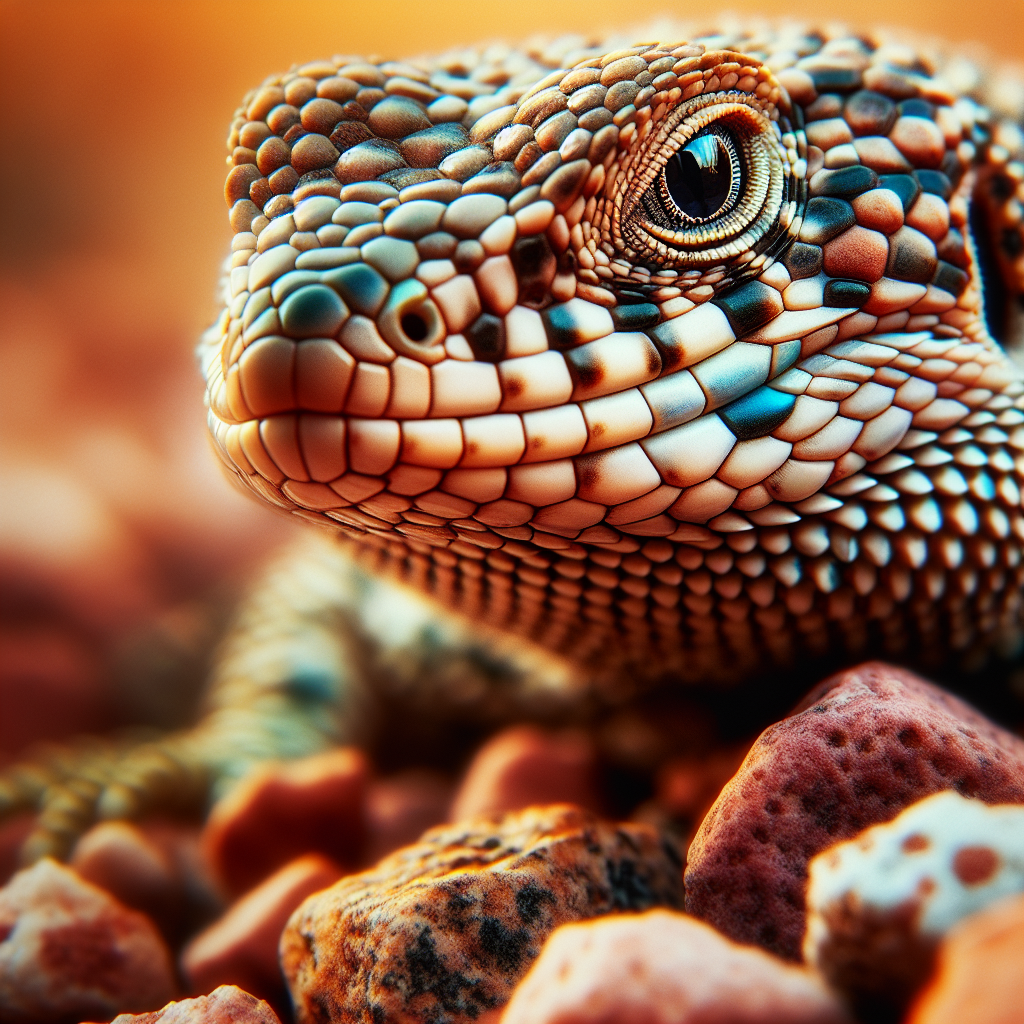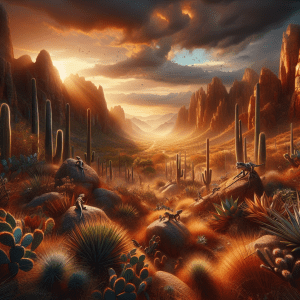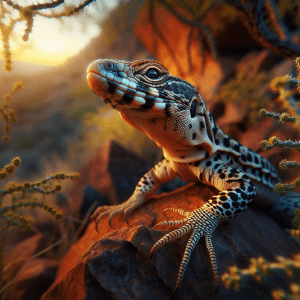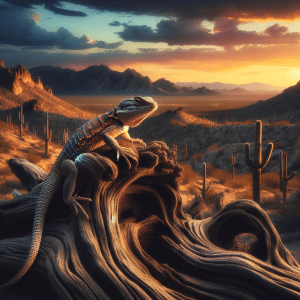Introduction to Lizard Life in the Sonoran Desert
Imagine you’re strolling through the vast expanse of the Sonoran Desert, the sun beating down on the arid landscape. Suddenly, a rustle catches your attention, and you spot a colorful lizard darting across a rocky outcrop. That’s the magic of encountering the diverse lizard life in the Sonoran Desert – a truly captivating experience that reveals the wonders of nature.
The Sonoran Desert is a haven for various lizard species, each uniquely adapted to survive in this harsh environment. From the iconic Gila monster to the swift and agile desert spiny lizard, these reptiles exhibit a fascinating array of behaviors and characteristics that make them a vital part of the desert ecosystem.
One interesting fact about lizard life in the Sonoran Desert is their remarkable ability to regulate body temperature in extreme heat. These cold-blooded creatures rely on basking in the sun to warm up and seek shade or burrows to cool down, showcasing their clever strategies for coping with the desert’s harsh climate.
As you delve deeper into the world of Sonoran Desert lizards, you’ll uncover a myriad of species with distinct traits and habits. Some lizards are expert climbers, scaling cacti and rocks with ease, while others are adept burrowers, disappearing into the sandy soil at the slightest hint of danger.
The challenge lies in understanding and protecting these unique creatures and their fragile habitats. Conservation efforts play a crucial role in preserving the delicate balance of the Sonoran Desert ecosystem, ensuring that future generations can continue to marvel at the beauty of these ancient reptiles.
So, the next time you find yourself in the Sonoran Desert, take a moment to appreciate the intricate tapestry of lizard life that thrives in this unforgiving landscape. Their presence serves as a reminder of nature’s resilience and the interconnectedness of all living things in this diverse and extraordinary ecosystem.
Types of Lizards Found in the Sonoran Desert
Have you ever stopped to marvel at the diversity of lizards found in the Sonoran Desert? It’s truly a sight to behold! From the iconic Gila monsters to the swift and agile chuckwallas, these desert dwellers come in all shapes and sizes.
Let me share an interesting fact with you – did you know that the Sonoran Desert is home to over 60 species of lizards? Each of these species has unique characteristics that help them thrive in this harsh environment. Some lizards, like the horned lizards, have evolved to blend in seamlessly with their surroundings, while others, such as the collared lizards, are known for their impressive speed and agility.
As we delve into the different types of lizards found in the Sonoran Desert, you’ll be amazed by the sheer variety of adaptations these creatures have developed over time. From the spiky scales of the regal horned lizard to the cryptic coloration of the desert iguana, each species has its own survival strategy that makes it perfectly suited to its desert home.
One practical tip I can offer when exploring the world of Sonoran Desert lizards is to keep your eyes peeled for movement among the rocks and desert vegetation. Lizards are masters of camouflage, but their quick movements and distinctive shapes can give them away if you’re observant.
So, next time you find yourself wandering through the Sonoran Desert, take a moment to appreciate the incredible diversity of lizards that call this place home. Who knows, you might just spot a chuckwalla basking in the sun or a zebra-tailed lizard darting across the sand. The world of Sonoran Desert lizards is full of surprises – all you have to do is look closely to discover its wonders.
Behavior and Adaptations of Sonoran Desert Lizards
Have you ever wondered why lizards in the Sonoran Desert are such fascinating creatures? Well, let me break it down for you. When we talk about the behavior and adaptations of these desert dwellers, it’s like diving into a whole new world of survival strategies and cool tricks.
Picture this: a lizard basking in the sun, seemingly motionless. But wait, there’s more than meets the eye. These clever critters have unique adaptations that help them thrive in the harsh desert environment. From their ability to regulate body temperature by changing color to their nimble movements that allow them to escape predators in the blink of an eye, Sonoran Desert lizards are true masters of adaptation.
Now, here’s an interesting fact for you: did you know that some lizards in the Sonoran Desert can detach their tails as a defense mechanism? It’s like a built-in escape plan! When a predator strikes, the lizard can detach its tail, leaving the predator distracted while the lizard makes a quick getaway. Talk about a sneaky survival tactic!
But it’s not all fun and games for these desert-dwelling lizards. One of the challenges they face is finding enough food and water to sustain themselves in the arid landscape. Their diet mainly consists of insects and other small creatures, and they have to be resourceful in hunting for their meals to stay nourished.
So, the next time you spot a lizard scurrying across the desert sand, take a moment to appreciate the incredible adaptations and behaviors that make these creatures so unique. They may be small, but Sonoran Desert lizards have some big tricks up their sleeves when it comes to surviving in one of the harshest environments on Earth.
Habitat of Lizards in the Sonoran Desert
When it comes to the habitat of lizards in the Sonoran Desert, it’s truly a sight to behold. Picture this – the vast expanse of the desert landscape, dotted with rocky outcrops, sparse vegetation, and the scorching sun beating down. This harsh environment is where Sonoran Desert lizards call home.
The Sonoran Desert provides a diverse range of habitats for these fascinating creatures. From the iconic saguaro cacti to the rugged canyons and arid washes, lizards have adapted to thrive in this challenging ecosystem. Some species seek shelter in rocky crevices, while others burrow into the sandy soil to escape the blistering heat of the day.
One interesting fact about the habitat of Sonoran Desert lizards is their ability to regulate their body temperature in extreme conditions. These cold-blooded creatures bask in the sun to warm up and retreat to shade or underground burrows to cool down. Their environment plays a crucial role in maintaining their body temperature and overall well-being.
As we observe these resilient creatures in their natural habitat, we can’t help but marvel at the intricate balance between survival and adaptation. The Sonoran Desert presents a unique challenge for lizards, where every rock, plant, and burrow plays a vital role in their existence.
So, the next time you find yourself in the Sonoran Desert, take a moment to appreciate the diverse and awe-inspiring habitat that supports the life of these remarkable lizards. It’s a reminder of the incredible resilience and adaptability of nature, where every aspect of the environment is intricately intertwined with the survival of its inhabitants.
Diet and Feeding Habits of Sonoran Desert Lizards
Imagine you’re exploring the Sonoran Desert, scanning the rocky terrain for a glimpse of a scaly creature darting across the sand. That’s the thrill of spotting lizards in their natural habitat. But have you ever wondered what these desert dwellers munch on to survive in such harsh conditions?
Well, let me share a fascinating tidbit with you – the diet and feeding habits of Sonoran Desert lizards are as diverse as the landscape itself. From the agile and carnivorous Gila Monster to the insect-loving Zebra-tailed Lizard, each species has its own unique culinary preferences.
Picture this: you’re observing a Chuckwalla, a plump and slow-moving lizard, leisurely munching on leaves and flowers. It might surprise you to learn that some desert lizards are actually herbivores, relying on plant matter for sustenance in an environment where food can be scarce.
Now, here’s a practical tip for all you aspiring lizard enthusiasts out there – if you want to catch a glimpse of these elusive creatures in action, try visiting rocky outcrops or desert washes during the early morning or late afternoon when they are most active. Patience and a keen eye are key when it comes to spotting these masters of camouflage.
As you ponder the intricate web of life in the Sonoran Desert, consider how these tiny reptiles play a crucial role in maintaining the delicate balance of this arid ecosystem. Their feeding habits not only shape their own survival but also impact the broader food chain, serving as both predator and prey in this unforgiving desert landscape.
So, the next time you find yourself in the Sonoran Desert, take a moment to appreciate the diverse and fascinating diet and feeding habits of these remarkable creatures. Who knows, you might just witness a lizard feast that will leave you in awe of nature’s incredible adaptations.
Reproduction and Life Cycle of Sonoran Desert Lizards
Reproduction and Life Cycle of Sonoran Desert Lizards is truly a fascinating topic. Did you know that some lizard species in the Sonoran Desert can reproduce asexually through a process known as parthenogenesis? It’s mind-blowing how these creatures have evolved unique ways to ensure their survival in such a harsh environment.
Imagine witnessing the birth of baby lizards in the desert! The life cycle of Sonoran Desert lizards is a marvel of nature. From the moment they hatch from their eggs to their growth into independent adults, every stage is crucial for their survival. It’s like a miniature drama unfolding in the vast expanse of the desert.
One interesting fact about these lizards is that their reproductive strategies can vary greatly among different species. Some lay eggs, while others give birth to live young. The diversity in their reproductive methods adds another layer of intrigue to their life cycle.
Understanding the reproductive patterns of Sonoran Desert lizards can shed light on how they adapt to their environment and ensure the continuation of their species. Have you ever wondered how these lizards navigate the challenges of reproduction in the harsh desert conditions? It’s a delicate balance between survival and adaptation.
As we delve into the world of Sonoran Desert lizards, we uncover not just their biological processes but also the interconnectedness of life in this unique ecosystem. The intricate dance of birth, growth, and reproduction plays a crucial role in maintaining the delicate balance of nature in the desert.
So, the next time you spot a lizard basking in the sun in the Sonoran Desert, take a moment to appreciate the incredible journey it has undertaken to reach that point in its life cycle. From egg to adult, these lizards embody resilience, adaptability, and the beauty of nature’s design.
Threats and Conservation Challenges Facing Sonoran Desert Lizards
Imagine you and I are sitting on a warm desert evening, surrounded by the mystical beauty of the Sonoran Desert. As we chat about the fascinating world of Sonoran Desert lizards, the conversation naturally shifts to the challenges these unique creatures face in their environment.
I’m reminded of a recent documentary I watched that highlighted the conservation efforts being made to protect the lizard populations in the Sonoran Desert. It’s incredible to think about the delicate balance these creatures must maintain to survive in such a harsh and ever-changing landscape.
The reality is that Sonoran Desert lizards are not immune to the threats of habitat loss, climate change, and human encroachment. It’s a sobering thought, isn’t it? Despite their remarkable adaptations and resilience, these creatures are facing an uphill battle for survival.
As we delve deeper into this topic, I can’t help but wonder about the long-term implications of these conservation challenges. What will the future hold for Sonoran Desert lizards if we don’t take action to protect their habitats and ensure their continued existence? It’s a thought-provoking question that underscores the importance of conservation efforts in preserving the rich biodiversity of this unique desert ecosystem.
So, next time you spot a lizard darting across the desert sands, take a moment to appreciate the intricate web of life that surrounds us. These seemingly small creatures play a vital role in maintaining the ecological balance of the Sonoran Desert, and it’s up to us to ensure that their legacy endures for generations to come.
Best Places to Spot Lizards in the Sonoran Desert
Have you ever tried to spot lizards in the Sonoran Desert? It’s like a real-life game of hide-and-seek! The Sonoran Desert is teeming with a variety of lizard species, each with its unique behaviors and habitats. When it comes to finding the best places to spot these elusive creatures, it’s all about knowing where and when to look.
Picture this: you’re hiking along a rocky trail in the early morning, the sun just starting to warm the desert landscape. As you approach a patch of boulders, you see a flash of movement out of the corner of your eye. You freeze, trying not to startle the lizard sunning itself on a rock. This thrill of discovery is what makes lizard spotting in the Sonoran Desert so exciting!
To increase your chances of spotting lizards in their natural habitat, it’s essential to know where they like to hang out. Look for rocky outcrops, desert washes, and areas with sparse vegetation. Lizards are masters of camouflage, so keep a sharp eye out for any movement or rustling in the undergrowth.
Another tip is to visit during the cooler hours of the day, such as early morning or late afternoon when lizards are more active. They tend to retreat to shady spots during the hottest part of the day to avoid the scorching desert sun.
Remember to tread lightly and respect the wildlife while observing lizards in the Sonoran Desert. Avoid disturbing their natural behavior or habitat, and always maintain a safe distance to prevent any unnecessary stress.
So, are you ready to embark on your own lizard-spotting adventure in the Sonoran Desert? Grab your binoculars, pack plenty of water, and get ready to witness the fascinating world of these desert-dwelling reptiles. Happy hunting!
Tips for Observing Lizard Life in the Sonoran Desert
Imagine you and I are out exploring the Sonoran Desert, on the lookout for fascinating lizards. Now, when it comes to observing lizard life in this unique ecosystem, there are a few tips and tricks to keep in mind to make the most of your experience.
First off, timing is key. Lizards are most active during the warmer parts of the day, so try to plan your observation sessions accordingly. Early mornings and late afternoons are usually prime lizard-spotting times, as they come out to bask in the sun or hunt for food.
When you’re out in the desert, remember to be patient and observant. Lizards are quick and agile creatures, so you’ll need to keep a keen eye out for any movement or rustling in the bushes. Try to move slowly and quietly to avoid startling them – remember, they’re just as curious about you as you are about them!
One handy tip is to pay attention to the type of habitat you’re in. Different species of lizards prefer different environments, so understanding their preferred habitats can increase your chances of spotting them. Look for rocky outcrops, desert washes, or areas with plenty of vegetation – these are all popular hangouts for Sonoran Desert lizards.
If you’re keen on photographing these elusive creatures, make sure to respect their space. Keep a safe distance and use a zoom lens to capture those up-close shots without disturbing them. And don’t forget to share your photos with us later – we’d love to see your lizard encounters!
Lastly, as we wrap up our lizard-hunting adventure, take a moment to appreciate the diversity of life that thrives in the Sonoran Desert. These resilient reptiles have adapted to survive in one of the harshest environments on Earth, and their presence here is a testament to the wonders of nature.
So, next time you find yourself in the Sonoran Desert, armed with these tips, get ready to embark on a lizard-spotting expedition like no other. Who knows what hidden treasures you might uncover in the world of lizard life in this captivating desert landscape?
Appreciating the Diversity of Lizard Species in the Sonoran Desert
When it comes to observing lizard life in the Sonoran Desert, it’s truly a fascinating experience that opens up a whole new world of discovery. Picture this – the blazing desert sun beating down on the rugged terrain, as you carefully scan the rocky outcrops and sandy patches for any signs of movement. Suddenly, a flash of color catches your eye, and there it is – a beautiful lizard basking in the sun, showcasing its remarkable adaptations for survival in this harsh environment.
One interesting fact about lizard life in the Sonoran Desert is their incredible diversity. Did you know that there are over 60 species of lizards found in this region, each with its own unique characteristics and behaviors? From the iconic Gila monster to the agile collared lizard, the Sonoran Desert is teeming with a variety of lizard species waiting to be discovered.
As you immerse yourself in the world of Sonoran Desert lizards, you might start pondering about the challenges these fascinating creatures face in their habitat. The delicate balance between human development and wildlife conservation raises important questions about the future of these species and the need to protect their natural habitats.
If you’re gearing up for a lizard-watching adventure in the Sonoran Desert, here’s a practical tip to enhance your experience – bring along a pair of binoculars or a camera with a zoom lens. This will allow you to observe these elusive creatures from a safe distance without disturbing their natural behavior.
As you venture into the Sonoran Desert in search of lizard life, take a moment to reflect on the broader significance of these creatures in the ecosystem. Lizards play a crucial role in maintaining the ecological balance by controlling insect populations and serving as prey for larger predators, highlighting the interconnectedness of all living organisms in this desert landscape.
So, are you ready to embark on a journey of discovery through the captivating world of lizard life in the Sonoran Desert? Get ready to be amazed by the beauty, resilience, and diversity of these fascinating creatures that call this arid landscape their home.




